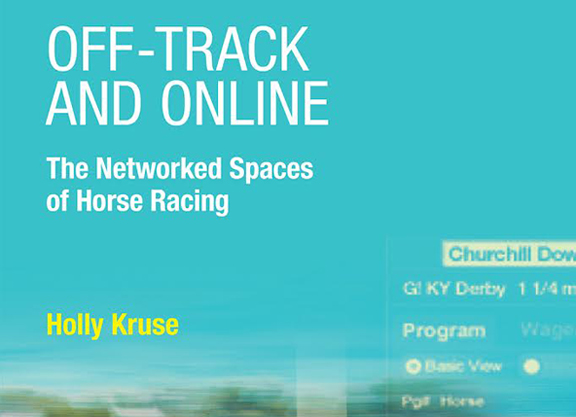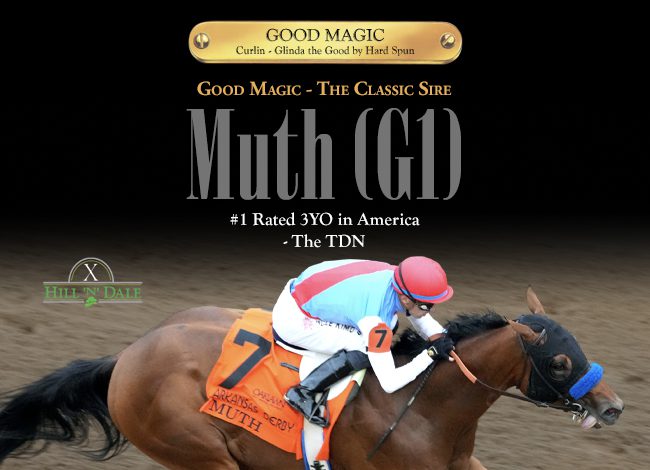By T. D. Thornton
How often have you heard that some entity within the sport is going to conduct a study into such-and-such an issue, and rolled your eyes because you know, just based on who is bankrolling the research, how that study is likely to turn out? Independent academic analyses of the inner workings of the United States racing industry are difficult to come by, and Holly Kruse, a communications professor at Rogers State University in Oklahoma, isn't shy about stating why in her provocative new book Off-Track and Online: The Networked Spaces of Horse Racing (The MIT Press, $39 hardcover).
“Perhaps horse racing, and gambling in general, despite its often pioneering use of new media and network technology, has been overlooked because the sport has lost vitality and popularity in the United States in the last few decades,” Kruse writes, “and/or because racetracks and off-track betting (OTB) facilities have been identified as places frequented by retired or unemployed, aging, working- or lower-class men.”
In making such a statement, Kruse isn't lobbing hollow criticism at the industry or picking on OTB clientele as easy targets. Rather, she has recently emerged from a scholarly foray into the grandstands of C-level racetracks, suburban sports-bar styled simulcast facilities, and gritty city OTB parlors to deliver a somewhat surprising challenge to fellow academics: New-media researchers are too focused on studying well-educated, relatively young, trend-setting users of cutting-edge communications methods, when more valuable information might be gleaned from the “less sexy” pockets of society where older methods of media coexist (and clash) with the latest and greatest technologies.
Maybe, as Kruse postulates in her book, those slices of sociology that are rife with late-adopters (read: racing's prime betting demographic of older males) are exactly what researchers need to be paying more attention to if they are truly seeking the clearest overall picture of America's communication networks.
En route to a doctorate in media studies, Kruse grew up as a fan in U.S. racing's 1970s glory era that was blessed with captivating Thoroughbreds. In the book's preface, she explains that she undertook Off-Track primarily to share her interest and expertise in communications with racing people who love the sport and are trying to make it better, but also to let non-racing researchers know about a fascinating, challenging industry that exists well off the periphery of conventional academia.
As her book unfolds, Kruse makes a salient case that the sport has a lot to offer researchers across various fields. For starters, racing is an enormous industry that depends on global communication and information flows. New media technologies, as they evolve, at once unsettle and reconstruct existing norms. A prime example of this in racing is the advent of simulcasting and at-home and mobile wagering over the past several decades, which has resulted in a landmark shift in the way the racing business operates. In 2016, the emphasis largely involves bringing the product to horseplayers rather than bringing horseplayers to the product.
But before Kruse dissects the present sociology of racetracks and their communications methods, she does an admirable job tracing the history of racing's past roles as a technological leader. Even if you're familiar with the history of the sport, you'll be surprised at the impressive list Kruse has compiled to detail how racing has been an innovating entity over the past 140 years or so, demonstrating how tweaks to various technologies that benefited the industry's business model eventually got picked up by other sectors.
The expanded capabilities of the telegraph and early “virtual” communications inventions like the totalizator are among such examples. “Horse racing is part of an overlooked history of media technologies,” Kruse writes, “the horse racing industry has been a pioneer in interactive media, in information networks, and in their deployment.”
So what happened? Why do we (as an industry) often feel (or get accused of being) behind the times in 2016? Kruse has an answer for that, too. “Yet for all of its innovation in the development and use of media and communication networks, the horse racing industry has often proven less than adept at making decisions about effective communication technology use,” she writes.
An extrapolation on this riff is that a vicious cycle sets up: Racing comes up with some new and useful technology (fantasy horse racing, for example), doesn't invest and improve upon it (while other sectors do), then gets bogged down with problems like regulatory stifling, legal woes, and infrastructural weaknesses. Finally, after being left so far behind other sectors in that particular innovation, the industry is desperate to try something new–and only then is willing to go out on a limb and come up with some other daring, breakthrough technology.
Or, as Kruse puts it, racing is quite adept at using new media “to compensate for poor use of older media.”
Off-Track is at its best when Kruse tells her tales from the trenches, and she even incorporates some of the good-natured (albeit stereotypical) flak she received from OTB denizens who were puzzled about why a woman would want to embed herself in their natural habitats to observe and record the largely male patrons' patterns of behavior.
Racetracks, Kruse underscores, are amazingly unlike other gambling venues in that they are inherently social. Racing patrons are more likely to make eye contact and engage in face-to-face conversations with strangers than casino customers, and the mechanics of other forms of gambling (slots, for example) are primarily repetitive, solitary, and stationary.
Kruse writes that racetracks and OTBs are rife with social juxtapositions of old ways of communication getting cycled out and new norms becoming established. And since change is a complex evolutionary process, those new methods don't automatically replace old ones; they will exist side by side for quite some time.
A good example of this, Kruse points out, can be seen at any typical track or simulcast location: Patrons are surrounded by technologies from various eras, like banks of TVs, smart phones, tablet computers, tote boards, self-service betting terminals, and actual human tellers. But most the common choice for the most important phase in wagering's transactional process–determining on which horse to bet–is still overwhelmingly driven by something as simple as a cheap paper program densely printed with agate lines of “information poor” statistics.
There are parts of the book that drag under the weight of Kruse's scholarly lens. The material that is less racetrack-specific (historical perspectives on interactive TV and sidelights about how our home lives are changed by technology) is not as entrancing. Yet just as I was getting into “skim mode” for the final third of the book, Kruse reawakened my interest with an intriguing take on something called “affective alliance.”
By this point in the book Kruse has moved on from studying in-person track or OTB behavior to delve into how social media and the “always on” nature of the Internet shape our personal feelings about the sport. Facts, opinions, and emotions can combine to drive “affective streams” that unite people for a cause. One example of how this collective power can be harnessed is the rescue of racehorses from slaughter.
In the 21st Century, an uploaded photo of a distressed Thoroughbred in a kill pen can, within minutes, spark research into a lip tattoo number, which in turn provides a back story that serves as an online narrative to determine the “redemptive capital” (rescue worthiness) of the horse in question. Once established, this context often ignites an exponential flurry of monetary donations and generous offers to re-home the doomed animal. All of this, Kruse asserts, has been unquestionably effective at helping to save innumerable imperiled racehorses. Social media has shifted our industry's paradigm on equine welfare and demonstrated the good that humans can do while reinforcing the idea that “images help drive emotional labor on the Internet.”
Yet, as a researcher, Kruse would be remiss if she didn't also explore the unintended ramifications of emotion-based networking. The circulation of content through affective networks can lull people into thinking they are participating in real change by hitting the Facebook “like” button rather than by helping a cause in a more active way. In other words, online affective networks produce “feelings of community, but not actual communities,” and one of Kruse's key conclusions about rescuing racehorses in this manner might make some within the sport uncomfortable.
“In fact, one could argue that rescuing retired racehorses enables those who use these horses for profit and then send them to likely death in slaughterhouses to maintain the status quo,” Kruse writes. “The rescuers help solve a pesky image problem for the racing industry, creating feel-good stories and saving the industry itself from having to get financially involved in racehorse rescue.”
Might the above statement be perceived as too provocative for some racing insiders? You bet. But that's just the point. Off-Track, although academically cumbersome in spots, is independently researched and written–and thus doesn't regurgitate the familiar points of view that the industry generally expects to hear when it commissions its own research studies.
Not a subscriber? Click here to sign up for the daily PDF or alerts.






